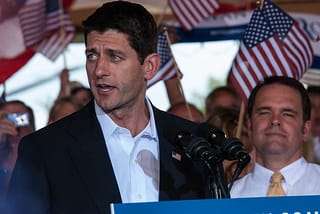It’s not hard to argue that many school-district budgets remain bloated, even after a few tough years of recession. With a major increase in spending since the mid 1990s, and a meteoric rise in the number of adults on the personnel rolls, surely most of our schools still have some cushion to get them through the current malaise. Moreover, the belt-tightening gives innovative leaders a chance to rethink the entire education enterprise in order to get much better results at much lower cost.
 Ryan and Romney are right that the Medicare goliath must be slain if we are to avoid a future in which there's no money to pay for education for decades to come. Photo by monkeyz_uncle |
That’s the theory. In reality, Americans say that lack of money is the greatest challenge facing public education today. And few districts seem to be availing themselves of the opportunity to rethink and restructure. Far more widespread is simply slashing: laying off young teachers, shuttering programs.
This only feeds the country’s palpable apprehensions about “national decline”—and the sense that we’re no longer investing in the future.
Enter President Obama, who went after Mitt Romney over the education implications of Paul Ryan’s budget plan this week, tersely distinguishing himself from his opponent in a speech yesterday: “He doesn’t think our children’s education is worth investing in. I do.”
This is a smart political strategy, designed to shore up his union base no doubt—the teachers who might not have liked Race to the Top but sure as heck don’t want to experience the federal budget cuts promised by Ryan. But it’s also not crazy from a substantive point of view. At a time when we’re running a trillion-dollar deficit, are we really sure that education is the place where cuts should come first?
But that doesn’t mean Obama is pristine on the “invest-in-the-future” front, either. For while he may want to spend billions more right now to prop up teachers’ jobs and keep class sizes from rising (billions borrowed from China, by the way), he has little to offer when it comes to protecting education budgets in the future. On that score, Romney and Ryan are the ones playing grown-ups when it comes to worrying about our kids.
The basic challenge—this is hardly news—is that America is aging and, as a result, is spending a lot of money on healthcare and retirement expenses. These expenses will go up and up in coming decades; they’re built into our demography. Unless economic growth can outpace the cost increase, however, that means less money for everything else—education included, along with national parks, mass transit, the arts, you name it.
So let’s say you want to protect the education budget and other investments in the young—in the future—at both the federal and state levels. The first thing you need to do is constrain public outlays for the old—which mostly means holding the line on healthcare spending. And the second thing you need to do is encourage maximum economic growth. Get both of these things right and you avoid Armageddon.
Now hold on, you say, there are other options. You can go after the defense budget. You can raise taxes on the rich. That’s true, and these might help at the margins, at least for a while. But as the chart below shows, defense spending is hardly putting pressure on education spending—healthcare is. And as many economists will tell you, if you tax the rich too aggressively, you’ll drive down economic growth. You might slice the pie more evenly but a smaller pie means less for everyone. (And taxing the rich won’t raise nearly enough revenue, anyway.)
 Notes: Sources here, here, and here. Education spending is all government outlays for K-12 and higher education. Healthcare spending is all expenditures, public or private. |
Which brings us back to the real options:
- Rein in healthcare spending. President Obama says the Affordable Care Act will do that, but there are many skeptics. Ryan’s approach—capping the amount of healthcare that government will pay for—by voucherizing Medicare and block-granting Medicaid—would almost surely do more to drive down healthcare spending, making room for education and everything else. Yes, this would lead to some form of “rationing,” at least for the publicly paid-for services. But you can either “ration” healthcare or you can “ration” education (and all other social spending). Take your pick. (And if you’re a governor, you can’t invest in education if your budget is increasingly squeezed by Medicaid—which is only growing larger under Obamacare.)
- Grow the economy. There’s a debate to be had here, too, with Democrats urging investments in infrastructure and public employee salaries and benefits, and Republicans calling for a simplified pro-growth tax code and a bunch of deregulation. A mix of the two is probably the right prescription—but higher taxes over the long-term would almost certainly backfire.
Just as Scott Walker’s purportedly “anti-educator” reforms freed up money in his state for more spending in the classroom, so would Paul Ryan’s “radical” reforms free up money for education nationwide—at least in the long-run.
In this case, both presidential tickets have it half right. Obama is correct to urge investments in education today; Paul-Ryan-cum-Ayn-Rand should find his domestic discretionary cuts elsewhere. But Ryan and Romney are right that the Medicare goliath must be slain if we are to avoid a future in which there’s no money to pay for education—or anything else—for decades to come.
Gentleman, for the sake of America’s future, how about you adopt each other’s best ideas and call it a day?
A version of this originally appeared on the Flypaper blog.
